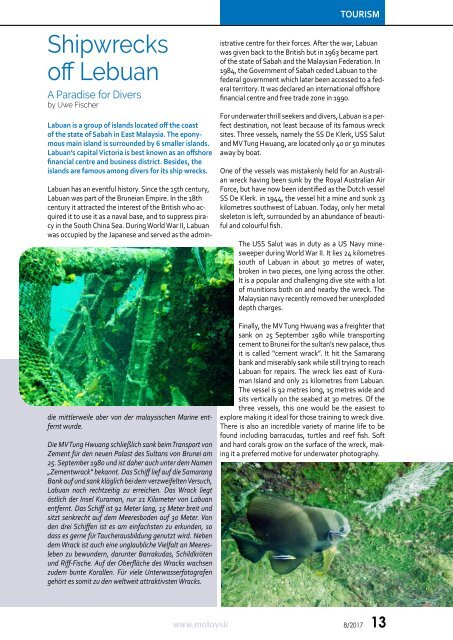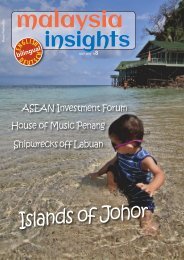MI8v6online-yumpu
Bilingual English/Deutsch. Topics: Welcome to Johor, Islands of Johor, Shipwrecks off Labuan, Metrochannel Malaysia, Malaysia 100 Years ago, House of Music Penang, ASEAN Forum in Frankfurt, Malaysian Minister in Germany, Anuga 2017, Carl Duisburg Centren
Bilingual English/Deutsch.
Topics: Welcome to Johor, Islands of Johor, Shipwrecks off Labuan, Metrochannel Malaysia, Malaysia 100 Years ago, House of Music Penang, ASEAN Forum in Frankfurt, Malaysian Minister in Germany, Anuga 2017, Carl Duisburg Centren
You also want an ePaper? Increase the reach of your titles
YUMPU automatically turns print PDFs into web optimized ePapers that Google loves.
Shipwrecks<br />
off Lebuan<br />
A Paradise for Divers<br />
by Uwe Fischer<br />
Labuan is a group of islands located off the coast<br />
of the state of Sabah in East Malaysia. The eponymous<br />
main island is surrounded by 6 smaller islands.<br />
Labuan’s capital Victoria is best known as an offshore<br />
financial centre and business district. Besides, the<br />
islands are famous among divers for its ship wrecks.<br />
Labuan has an eventful history. Since the 15th century,<br />
Labuan was part of the Bruneian Empire. In the 18th<br />
century it attracted the interest of the British who acquired<br />
it to use it as a naval base, and to suppress piracy<br />
in the South China Sea. During World War II, Labuan<br />
was occupied by the Japanese and served as the admin-<br />
die mittlerweile aber von der malaysischen Marine entfernt<br />
wurde.<br />
Die MV Tung Hwuang schließlich sank beim Transport von<br />
Zement für den neuen Palast des Sultans von Brunei am<br />
25. September 1980 und ist daher auch unter dem Namen<br />
„Zementwrack“ bekannt. Das Schiff lief auf die Samarang<br />
Bank auf und sank kläglich bei dem verzweifelten Versuch,<br />
Labuan noch rechtzeitig zu erreichen. Das Wrack liegt<br />
östlich der Insel Kuraman, nur 21 Kilometer von Labuan<br />
entfernt. Das Schiff ist 92 Meter lang, 15 Meter breit und<br />
sitzt senkrecht auf dem Meeresboden auf 30 Meter. Von<br />
den drei Schiffen ist es am einfachsten zu erkunden, so<br />
dass es gerne für Taucherausbildung genutzt wird. Neben<br />
dem Wrack ist auch eine unglaubliche Vielfalt an Meeresleben<br />
zu bewundern, darunter Barrakudas, Schildkröten<br />
und Riff-Fische. Auf der Oberfläche des Wracks wachsen<br />
zudem bunte Korallen. Für viele Unterwasserfotografen<br />
gehört es somit zu den weltweit attraktivsten Wracks.<br />
TOURISM<br />
istrative centre for their forces. After the war, Labuan<br />
was given back to the British but in 1963 became part<br />
of the state of Sabah and the Malaysian Federation. In<br />
1984, the Government of Sabah ceded Labuan to the<br />
federal government which later been accessed to a federal<br />
territory. It was declared an international offshore<br />
financial centre and free trade zone in 1990.<br />
For underwater thrill seekers and divers, Labuan is a perfect<br />
destination, not least because of its famous wreck<br />
sites. Three vessels, namely the SS De Klerk, USS Salut<br />
and MV Tung Hwuang, are located only 40 or 50 minutes<br />
away by boat.<br />
One of the vessels was mistakenly held for an Australian<br />
wreck having been sunk by the Royal Australian Air<br />
Force, but have now been identified as the Dutch vessel<br />
SS De Klerk. in 1944, the vessel hit a mine and sunk 23<br />
kilometres southwest of Labuan. Today, only her metal<br />
skeleton is left, surrounded by an abundance of beautiful<br />
and colourful fish.<br />
The USS Salut was in duty as a US Navy minesweeper<br />
during World War II. It lies 24 kilometres<br />
south of Labuan in about 30 metres of water,<br />
broken in two pieces, one lying across the other.<br />
It is a popular and challenging dive site with a lot<br />
of munitions both on and nearby the wreck. The<br />
Malaysian navy recently removed her unexploded<br />
depth charges.<br />
Finally, the MV Tung Hwuang was a freighter that<br />
sank on 25 September 1980 while transporting<br />
cement to Brunei for the sultan’s new palace, thus<br />
it is called “cement wrack”. It hit the Samarang<br />
bank and miserably sank while still trying to reach<br />
Labuan for repairs. The wreck lies east of Kuraman<br />
Island and only 21 kilometres from Labuan.<br />
The vessel is 92 metres long, 15 metres wide and<br />
sits vertically on the seabed at 30 metres. Of the<br />
three vessels, this one would be the easiest to<br />
explore making it ideal for those training to wreck dive.<br />
There is also an incredible variety of marine life to be<br />
found including barracudas, turtles and reef fish. Soft<br />
and hard corals grow on the surface of the wreck, making<br />
it a preferred motive for underwater photography.<br />
www.malaysia-insights.de 8/2017 13







